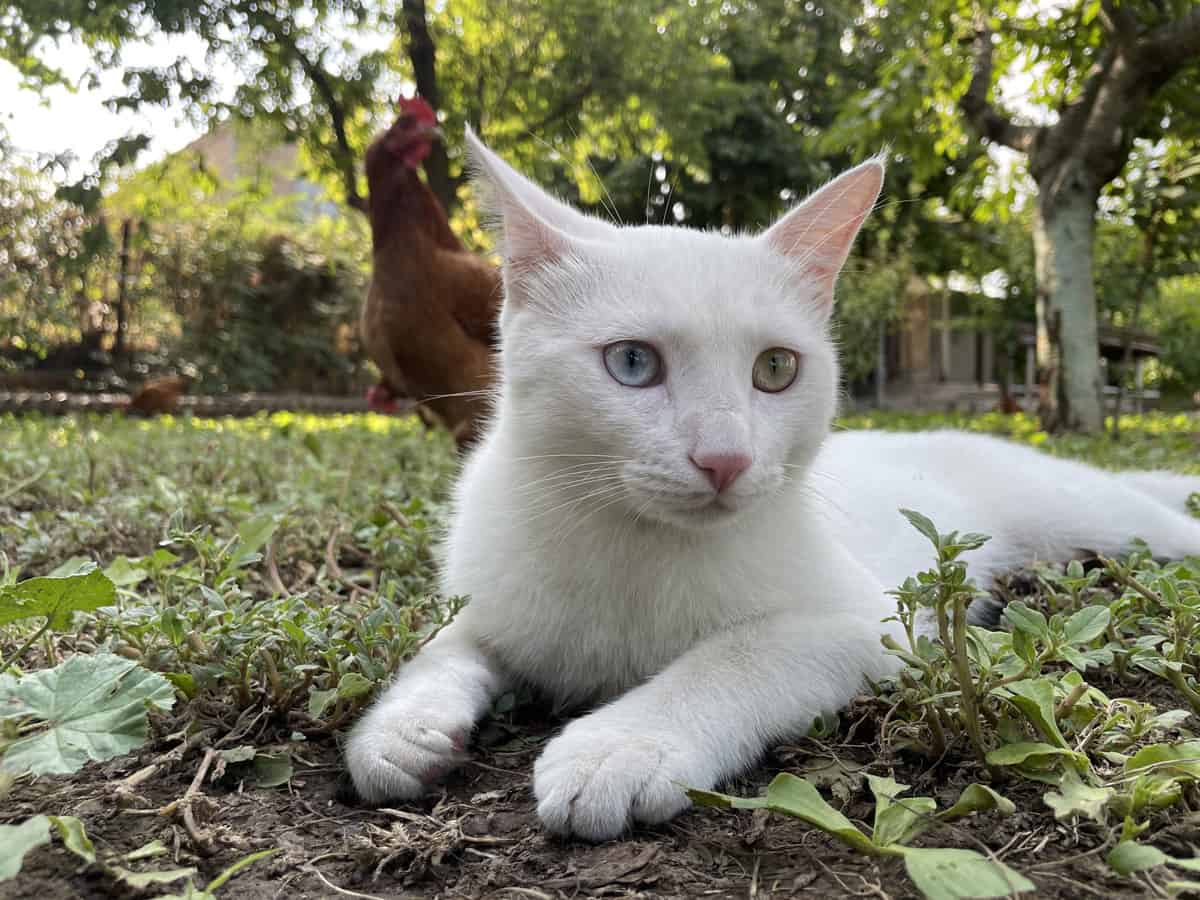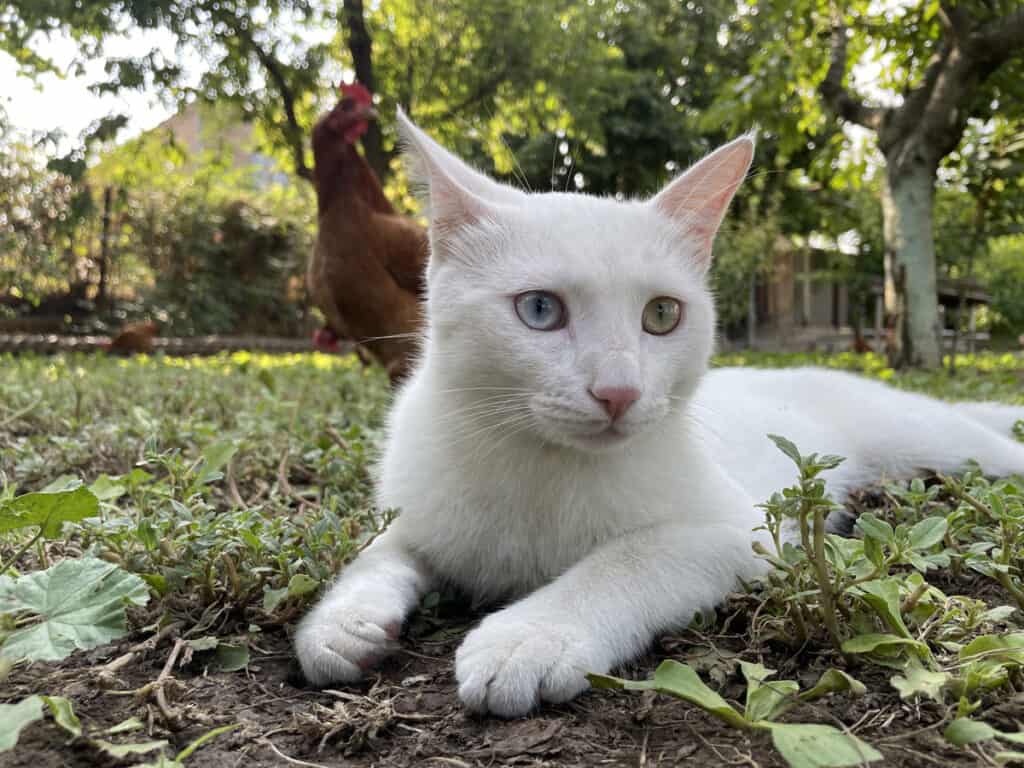The Van Cat, also known as the Van Kedesi in Turkish, is named after the region in Turkey where the cat originated, the Lake Van area in the eastern part of the country.
What do Van cats look like?
Van cats are know for their all-white fur and prevalence of heterochromia. Heterochromia is a genetic condition that causes Van cats to have two different-colored eyes. Van cats will either have two blue eyes, two amber eyes, or one eye that is blue and one eye that is amber.

The Van Cat is a medium to large-sized breed, with males typically weighing between 10 and 20 pounds and females weighing between 7 and 12 pounds. They have a long, lean body and a fluffy tail.
Is the Van cat the same as the Turkish Van?
Despite similar names, the Van cat is technically the not the same as the Turkish Van although many sources, including academic papers, conflate the two names.
The Turkish Van is a semi-long-haired cat breed that originates from the United Kingdom. The Turkish Van cat breed was developed in 1955 in Britain from natural van cats brought to the country from Turkey.

The Turkish Van cat is named after the “Van pattern” which is a bicolor cat that is all-white except for markings on the head and the tail. Turkish Van cats carry the carry the piebald gene which is responding for this fur pattern.
In contrast, Van cats are almost always all-white cats and are a natural breed (landrace) of cats that originated without human intervention around the Lake Van area of Turkey. The Van cat is named after Lake Van where the cat originated from.
History of the Van cat
The exact origin of the Van cat is unknown, but it’s believed to be a landrace breed (a naturally evolved type of cat) that has lived in the Lake Van area in Turkey for thousands of years. Researchers believe that the breed’s distinctive coloring is the result of a genetic mutation that occurred naturally in the population.
For centuries, the Van cat lived in the wild, hunting and surviving in the rugged terrain around Lake Van. But as the region became more settled and developed, the cats began to interact more with humans. This led to the breed’s domestication, as people began to take in the cats as pets and appreciate their unique qualities.
Selective breeding of the Van cat has resulted in the all-white coat and high prevalence of heterochromia.
In the 1950s, Turkish authorities began to take notice of the Van Cat and launched efforts to protect and preserve the breed. Today, the Van Cat is a protected species in Turkey, and there are strict regulations governing the breeding and export of these cats.
Personality characteristics of the Van cat
As mentioned earlier, the Van Cat is known for its striking white fur and heterochromia. But there’s more to this breed than just its appearance.
One of the most notable characteristics of the Van Cat is its love of water. Unlike most cats, the Van Cat enjoys swimming and playing in water, a trait that’s believed to have developed as a result of the breed’s natural habitat around Lake Van. In fact, some Van Cats have been known to swim in the lake itself.
The Van Cat is also known for its intelligence and playful nature. These cats are highly active and require lots of mental and physical stimulation to stay happy and healthy. They enjoy playing with toys, exploring their surroundings, and spending time with their human family.
A rare cat breed
Van cats are cats that are specific to the Lake Van region and, as a result, are rare. The Van Cat Research and Application Center based at Van Yüzüncü Yıl University, is dedicated to the preservation and protection of this cat species.
The Center launched a program in 1992 with the tagline, “A Van Cat in Every Household” to prevent the extinction of the Van cat.
The program is an effort to increase the adoption by Turkish households of this rare care breed. Each year, about 100 Van cats are adopted out to Turkish residents and tracked using ID cards. Adoptions outside of Turkey are rare but are allowed with proper permitting.
References
Anadolu Agency. (2022, July 10). Turkish research center puts hundreds of van cats up for adoption. Daily Sabah. https://www.dailysabah.com/life/turkish-research-center-puts-hundreds-of-van-cats-up-for-adoption/news
Cak, B. (2017). Turkish Van cat and Turkish Angora cat: a review. J Agric Sci Technol A, 7(3), 151-159. doi: 10.17265/2161-6256/2017.03.002
Van cat center raising awareness, protecting felines. (2018, September 22). Hürriyet Daily News. https://www.hurriyetdailynews.com/van-cat-center-raising-awareness-protecting-felines-137091
Van cats poised to escape extinction at university. (2014, December 16). Hürriyet Daily News. https://www.hurriyetdailynews.com/van-cats-poised-to-escape-extinction-at-university-75699







